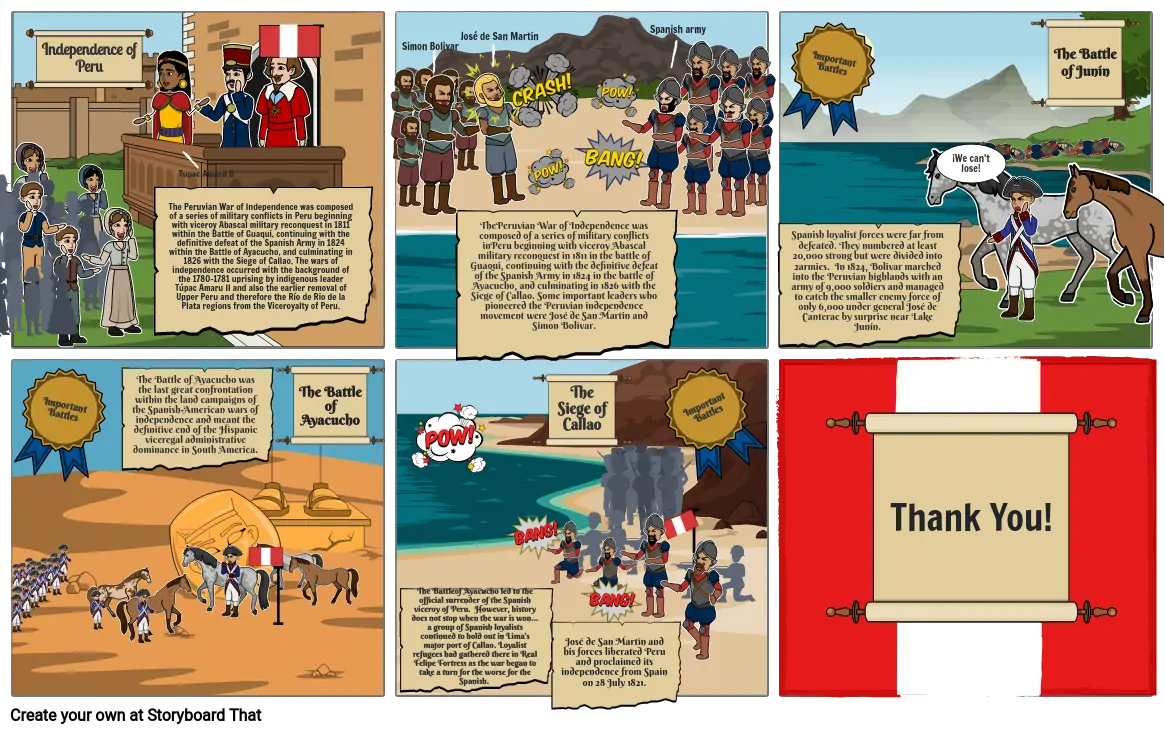Peruvian Revolution/War of Independence

Storyboard Description
The Peruvian War of Independence was composed of a series of military conflicts in Peru beginning with viceroy Abascal military reconquest in 1811 within the Battle of Guaqui, continuing with the definitive defeat of the Spanish Army in 1824 within the Battle of Ayacucho, and culminating in 1826 with the Siege of Callao. The wars of independence occurred with the background of the 1780–1781 uprising by indigenous leader Túpac Amaru II and also the earlier removal of Upper Peru and therefore the Río de Rio de la Plata regions from the Viceroyalty of Peru. The Peruvian War of Independence was composed of a series of military conflicts in Peru beginning with viceroy Abascal military reconquest in 1811 in the battle of Guaqui, continuing with the definitive defeat of the Spanish Army in 1824 in the battle of Ayacucho, and culminating in 1826 with the Siege of Callao. Some important leaders who pioneered the Peruvian independence movement were José de San Martin and Simon Bolivar.Spanish loyalist forces were far from defeated. They numbered at least 20,000 strong but were divided into 2armies. In 1824, Bolivar marched into the Peruvian highlands with an army of 9,000 soldiers and managed to catch the smaller enemy force of only 6,000 under general José de Canterac by surprise near Lake Junín. The Battle of Ayacucho was the last great confrontation within the land campaigns of the Spanish-American wars of independence and meant the definitive end of the Hispanic viceregal administrative dominance in South America. The Battleof Ayacucho led to the official surrender of the Spanish viceroy of Peru. However, history does not stop when the war is won… a group of Spanish loyalists continued to hold out in Lima’s major port of Callao. Loyalist refugees had gathered there in Real Felipe Fortress as the war began to take a turn for the worse for the Spanish. José de San Martín and his forces liberated Peru and proclaimed its independence from Spain on 28 July 1821.
Storyboard Text
- Independence of Peru
- The Peruvian War of Independence was composed of a series of military conflicts in Peru beginning with viceroy Abascal military reconquest in 1811 within the Battle of Guaqui, continuing with the definitive defeat of the Spanish Army in 1824 within the Battle of Ayacucho, and culminating in 1826 with the Siege of Callao. The wars of independence occurred with the background of the 1780–1781 uprising by indigenous leader Túpac Amaru II and also the earlier removal of Upper Peru and therefore the Río de Rio de la Plata regions from the Viceroyalty of Peru.
- Tupac Amaru II
- Simon Bolivar
- José de San Martin
-
- ThePeruvian War of Independence was composed of a series of military conflicts inPeru beginning with viceroy Abascal military reconquest in 1811 in the battle of Guaqui, continuing with the definitive defeat of the Spanish Army in 1824 in the battle of Ayacucho, and culminating in 1826 with the Siege of Callao. Some important leaders who pioneered the Peruvian independence movement were José de San Martin and Simon Bolivar.
- Spanish army
- Spanish loyalist forces were far from defeated. They numbered at least 20,000 strong but were divided into 2armies. In 1824, Bolivar marched into the Peruvian highlands with an army of 9,000 soldiers and managed to catch the smaller enemy force of only 6,000 under general José de Canterac by surprise near Lake Junín.
- Important Battles
- ¡We can't lose!
- The Battle of Junín
- Important Battles
- The Battle of Ayacucho was the last great confrontation within the land campaigns of the Spanish-American wars of independence and meant the definitive end of the Hispanic viceregal administrative dominance in South America.
- The Battle of Ayacucho
- The Battleof Ayacucho led to the official surrender of the Spanish viceroy of Peru. However, history does not stop when the war is won… a group of Spanish loyalists continued to hold out in Lima’s major port of Callao. Loyalist refugees had gathered there in Real Felipe Fortress as the war began to take a turn for the worse for the Spanish.
- The Siege of Callao
- José de San Martín and his forces liberated Peru and proclaimed its independence from Spain on 28 July 1821.
- Important Battles
- Thank You!
Over 30 Million Storyboards Created

